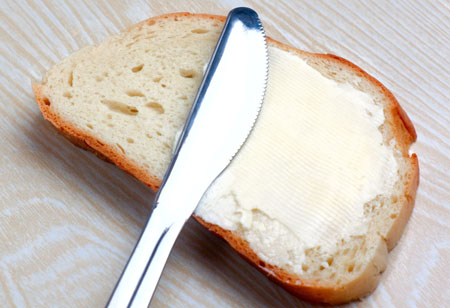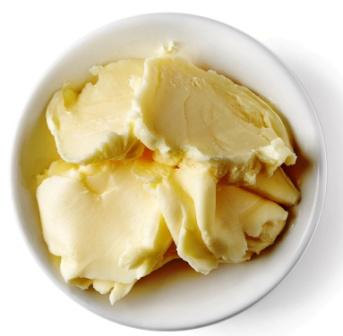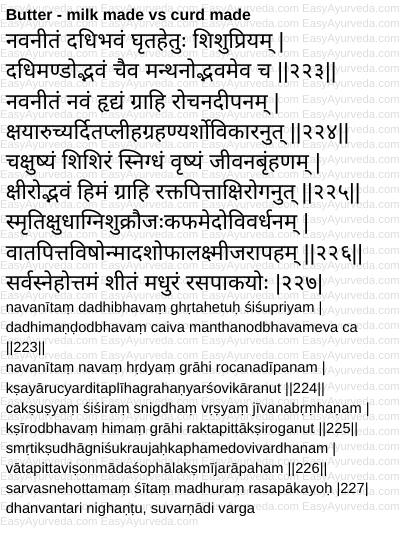Butter Benefits: Ayurveda Details
Butter is one of the food article that is used in many health conditions in Ayurveda. Here are the benefits of butter.

Table of Contents
Qualities of butter
Ayurveda, the Indian system of medicine explains the benefits of butter as follows –
- Butter is sweet in taste, it is a natural coolant.
- Butter improves taste and digestion
- Butter nourishes the body.
- Butter calms Vata and Pitta.
- According to Ayurveda, Butter is used as a dietary ingredient in conditions like indigestion and Pitta imbalance.
- Butter is also useful in eye related disorders
Butter benefits
Vrushya – aphrodisiac,
Sheeta – coolant
Varna, bala, agnikrut – improves skin complexion, strength and digestion strength.
Sangrahi – absorbent, useful in diarrhoea
Vatapittasruk jit – balances Vata, Pitta and detoxifies blood
Useful in
Kshaya – chronic respiratory disorders leading to emaciation
Arsha – haemorrhoids
Ardita vata – paralysis
Kasa – cough
The butter made directly from milk is
Sangrahi – absorbent, useful in diarrhoea
Raktapittajit – useful in bleeding disorders
Akshirogajit – useful in eye diseases.
Benefits as per Bhojana Kutuhala
Butter which is freshly extracted is cooling in nature, aphrodisiac, improves complexion, imparts strength, is very sweet in taste, cures all type of pains, treats cough, improves voice,lustre and nourishes the body, is absorbent, checks bleeding disorders and ophthalmic disorders.
Ayurvedic reference
सङ्ग्राहि दीपनं हृद्यं नवनीतं नवोद्धृतम्|
ग्रहण्यर्शो विकारघ्नमर्दितारुचि नाशनम्||२३०||
saṅgrāhi dīpanaṃ hṛdyaṃ navanītaṃ navoddhṛtam|
grahaṇyarśo vikāraghnamarditāruci nāśanam||230|| – Charaka Samhita Sutrasthana 27
Fresh butter is digestive, stimulant and a cardio tonic. It is useful in malabsorption syndrome (IBS), piles, facial paralysis and anorexia.
as per Dhanvatnari nighantu –
vātapitta – Balances Vata and Pitta
viṣa, unmāda śopha alakṣmī jarāpaham – useful in toxic conditions, mental disorders, inflammation, bad luck, and aging disorders
sarvasnehottamaṃ – best among all fats
śītaṃ – cold
madhuraṃ rasapākayoḥ – sweet taste, sweet post-metabolic taste
Home Remedies
By Dr MS Krishnamurthy MD(Ayu), PhD
Butter is the queen of fats. It is appreciated well as a rich source of vitamins A, D, E, and K which needed for good functioning of both body and mind.
Vitamin A is more easily absorbed and utilized from butter than from other sources. It also contains trace elements such as Manganese, Zinc, Chromium, Selenium, and Iodine.
Butter contains glyco-sphingo-lipids, a type of special kind of fatty acid; this safeguards the gut against several gastrointestinal infections.
But people are afraid about butter only with the reason that it is fatty and makes the body stout and blocks the vessels due to high cholesterol!
A moderate usage of butter, a teaspoon or two per day is okay for everyone.

Sex power
1. Butter and sugar emulsion for sex power:
2 tablespoon of butter and 1 tablespoon of sugar candy powder are taken together and mixed thoroughly. This is consumed once in a day preferably during bed time. This improves sperm count and semen quantity. But in case of high viscosity of semen(very thick semen), it is better to avoid butter.
Dryness of skin
2. Butter in lip crack and dryness of the skin:
Local application of butter helps to pacify cracked lips, mouth ulcer, scalds, burning sensation and dry skin.
Skin glow
3. Butter with saffron for skin glow:
A pinch of saffron is dissolved in half spoon of butter and consumed daily. This helps to enhance the glow especially in pregnant mothers during second trimester. Also this helps to improve weight of the fetus.
Read related: Ayurvedic Remedies, Medicines for Skin Glow, Complexion
Headache
4. Butter application to the scalp:
In cases of severe headache, burning of the scalp and eyes, half spoon of butter is taken and is applied to the middle of the scalp (preferably buffalo’s butter is used).
Heamorrhoids
5. Jaggery mixed butter in haemorrhoids:
In chronic haemorrhoids 1 teaspoon of butter is mixed with a teaspoon of jaggery and administered early in the morning in the empty stomach. This helps to cool down the body, improves appetite and useful to heal bleeding hemorrhoids.
Read related: Buttermilk Home Remedy For Hemorrhoids [Video]
Chronic cough
6. Honey mixed butter in chronic cough:
Butter and honey are mixed in equal quantities and patient is asked to lick it. This helps to pacify chronic cough, hoarseness of voice and feeble voice caused after paralysis.
Read related: 6 Quick Natural Remedies To Improve Singing Voice
Digging the medicinal property and serving with particular adjuvant makes a formulation unique in its affect. Butter is also not an exception for this.
Click to consult Dr MS Krishnamurthy MD(Ayu), PhD
How to make butter?
Butter is one of the important dietary article. There are different opinion on How to make butter. Here is the Ayurvedic method of making butter.
Steps of making butter:
1. First you need to collect at least 100 – 250 grams (3 ounce to 8 ounce) of milk cream.
How to make milk cream?
Boil milk. Allow it to cool by itself. Collect the upper cream part. Keep it in the refrigerator. Do it everyday, till the time you have sufficient amount of milk cream to make butter.
2. After having sufficient milk cream collected in refrigerator, take it out from refrigerator and add a little amount of curd or buttermilk at night time. Leave it over night at room temperature.
3. Next day morning, churn it. You can adopt different techniques for churning.
4. Churning in a bottle. – Take the thus prepared milk cream in a bottle. Fill it up to 75 % space in the bottle. (3/4th volume of the bottle.) Close the lid tightly. Keep on shaking till you can see the butter collecting as the top layer of milk cream. Once the top layer of butter is completely formed, collect it and keep it in an air tight container.
5. Mixer method – You can churn the milk cream by a mixer.
6. Churning with the help of a churning machine.
Make sure to stop churning once you can clearly see the collected top layer of butter. If you over churn butter may get dissolved, leading to less yield.
Butter from milk cream vs. from curd
Butter can be prepared from the milk cream or from the curd.
In Ayurveda, butter prepared from the curd is called Dadhimandottha Navaneeta or Dadhyottha Navaneeta.
Butter from milk cream – Sizeable milk cream is collected over a period of a few days, then it is blended in a mixer or shaken in a bottle continuously to obtain the butter.
There are minor difference between these two products, which is beautifully explained by an ancient Ayurvedic book – Dhanvantari Nighantu.

Butter from curd
This is obtained by blending the curd.
Milk is curdled to prepare the curd. This curd is blended in a mixer or in a bottle by continuous shaking till the butter is formed. It is then washed with water and collected.
Here, the fermentation process is involved.
Qualities:
navanītaṃ dadhibhavaṃ ghṛtahetuḥ – the butter obtained from curd is best for preparing ghee.
śiśupriyam – it is liked by infants
navanītaṃ navaṃ hṛdyaṃ – such butter from curd, freshly prepared is good for heart
grāhi – water absorbing, useful in IBS, leaky gut syndrome etc.
rocana – promotes taste
dīpanam – promotes digestion strength
useful in
kṣaya- depleted body tissues
aruci – useful in anorexia
ardita – paralysis, facial palsy (improves blood circulation, soothes and rejuvenates nerves and muscles)
plīha – spleen related disorders, splenomegaly
grahaṇi – Irritable bowel syndrome
arśovikāranut – useful in hemorrhoids, both for oral intake and local application to relieve pain, burning sensation, bleeding and itching.
cakṣuṣyaṃ – good for eyes
śiśiraṃ – coolant
snigdhaṃ – unctuous
vṛṣyaṃ – aphrodisiac
jīvana – enlivening
bṛṃhaṇam – nourishing
Butter from milk
kṣīrodbhavaṃ – butter prepared from milk and its cream,
himaṃ – coolant
grāhi – water absorbent
raktapitta – balances Pitta Dosha, useful in bleeding disorders
ākṣiroganut – useful in eye disorders
smṛti – increases memory
kṣudha – increases hunger
agni – improves digestion strength
śukra – aphrodisiac
ojaḥ – improves immunity
kapha – increases Kapha Dosha
medovivardhanam – increases fat tissue
Difference between the two
The butter obtained from curd has a prior fermentation process in curd making. Fermentation brings with it some amount of hotness. This adds a little amount of sourness and astringency to the butter. This makes the butter less Kapha promoting, less fat promoting and more absorbent and more digestion promoting.
The butter obtained from milk straight away carries the sweetness and nourishing qualities of the milk. So, it is more nourishing than the curd-butter, more Kapha promoting, more Vata – Pitta balancing and more fat promoting in nature. It is cooler.
Types of butter
Salted Butter
Logic –
Butter balances Vata and Pitta Dosha.
Salt increases Pitta Dosha.
Tridosha effect:
So, action of salted butter is – balances Vata Dosha. Neutral on Pitta, increases Kapha due to its innate nature + the salt effect.
Taste – Sweet (innate), salty (as it is salted)
Qualities – unctuous (innate), light
Potency – cold (innate) , not very hot (salty)
After digestion taste transformation (Vipaka) – sweet (both innate and because salt has sweet vipaka)
Dosha –
Butter decreases Pitta, salt increases Pitta – neutral effect on Pitta
Butter balances Vata, Salt balances Vata – balances Vata
Butter increase Kapha, salt increases Kapha – increases kapha
Butter, whipped with salt
Whipped butter is lighter than plain butter.
Logic –
Butter balances Vata and Pitta Dosha.
Salt increases Pitta Dosha.
Tridosha effect:
So, action of salted butter is – balances Vata Dosha. Neutral on Pitta, increases Kapha but not to a greater extent (butter innately increases Kapha, Salt increases Kapha, but whipped butter is light and reduces the extent of Kapha increase)
Taste – Sweet (innate), salty (as it is salted)
Qualities – cold unctuous (innate), light, unctuous (salt)
Potency – cold (innate) , not very hot (salty)
After digestion taste transformation (Vipaka) – sweet (both innate and because salt has sweet vipaka)
Dosha –
Butter decreases Pitta, salt increases Pitta – neutral effect on Pitta
Butter balances Vata, Salt balances Vata – balances Vata
Whipped butter does not greatly increase Kapha, salt increases Kapha – slightly increases kapha.
Butter oil, anhydrous
Butter oil is a dairy product which is created by removing the moisture and the non-fat milk solids contained in butter
Butter oil is really great for people with intolerance to milk lactose or casein, as it contains very little of these both. It is also called clarified butter.
Taste – sweet (innate)
Qualities – light, penetrating unctuous (innate)
Potency – cold (innate)
After digestion taste transformation (Vipaka) – sweet(innate)
Action on Doshas
Balances Vata and Pitta
Increases Kapha
Butter, without salt
Rasa – sweet
Guna – heavy, unctuous
Veerya – cold
Vipaka – sweet
Effect on Doshas
Vata balancing – due to sweetness, heaviness, unctuousness
Pitta balancing – due to sweetness, coldness
Kapha increasing – due to sweet, heavy unctuous nature, it is nourishing to the body









16 comments
A-kay
What about the claim that the saturated fat in butter is not good for heart, raises cholesterol and such? What is the response from Ayurveda’s POV on this?
Dr J V Hebbar MD(Ayu)
Yes it is true in deed. That is why, butter is not advised in people having Kapha body type or patients having Kapha pridominant disorder like oebsity, diabetes etc.
Butter in Ayurveda, is only advised for selective patients having Vata and Pitta imbalance.
There is a famous statement in Ayurveda, which holds good for all the medical sciences.
“If used wisely, even a poison can be effective medicine.
The best of medicines, in the hands of a doctor without wisdom is poison. ”
Hope the question is answered.
nimi
What you said in the comment is very true doctor !
I think if a persons agni is in good shape then it won’t have the undesired effect even on heart.
we cannot expect people with cholestrol and such to be having a proper agni .
And butter is considered as rakta stambhaka and so good in bleeding conditions.
Purush
Doctor!
I am curious to know as to what Ayurveda says about Ghee. I could not locate any of your article on this. If any article is available I shall be obliged if you can kindly provide the link.
Dr J V Hebbar MD(Ayu)Author
It will be slightly hard to digest. You can add a bit of black pepper over it for easy digestion.
Sunny
Ok thanks. Do you any article about Ayurveda’s views on Sweet Potaoes or yams?
Thanks
Dr J V Hebbar MD(Ayu)Author
https://www.easyayurveda.com/2016/12/29/home-remedies-peripheral-neuritis/
https://www.easyayurveda.com/2017/10/05/konjac-elephant-foot-yam/
https://www.easyayurveda.com/2017/04/02/elephant-yam-home-remedies/
Ishwar Bhat
Between how many days the butter should be consumed?
Dr J V Hebbar MD(Ayu)Author
Twice a week should be fine.
Joban
Doctar i have high appetite and also suffering trapped gas and bloating in stomach. Can i take butter?
Dr J V Hebbar MD(Ayu)Author
Buttermilk is better.
Yagnik Tejas
Dr. J. V. Hebbarsir, Please give me reference on the line you’ve told that,”If used wisely, even a poison can be effective medicine.
The best of medicines, in the hands of a doctor without wisdom is poison.”
I’m very curious to know about this it touched my soul.??
And also there is suggestion that please also make articles on traditional talks of gods and sages described in ayurvedic texts. ???
Dr J V Hebbar MD(Ayu)Author
योगादपि विषं तीक्ष्णमुत्तमं भेषजं भवेत्| भेषजं चापि दुर्युक्तं तीक्ष्णं सम्पद्यते विषम्||१२६||
yogādapi viṣaṃ tīkṣṇamuttamaṃ bheṣajaṃ bhavet| bheṣajaṃ cāpi duryuktaṃ tīkṣṇaṃ sampadyate viṣam||126||
Charaka Samhita Sutrastahan 1/126
Richa
Dear Dr. Hebbar,
Request you pls adv. if it’s good to use the combination of olive oil and butter. Here in USA there recent introduction of butter that has combination of olive oil with butter and salt. This is done by some of the brands to increase unsaturated fat and reduce saturated fat due to olive oil mixed with butter. It looks just like normal butter. Are these two compatible together and is it okay to consume this type of butter.
Dr J V Hebbar MD(Ayu)Author
I think it is fine to consume.
Mark
what fruit or vegetable would combine very well with butter?